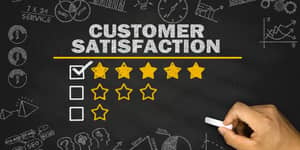When you walk into a supermarket, why is it you always see the fruit and veg first? Or smell fresh bread from the bakery? This is consumer psychology in use! They do this to employ the impression of freshness to the shopper as they walk through the doors.
In retail, business owners set out to guide their customer's shopping experience, and create an environment that encourages sales and increases the overall basket value.
For online businesses, the principles are exactly the same. While you can't physically drive the customer through a set route like Ikea, you can integrate intuitive navigation and item suggestions to do the same thing!
Utilising consumer psychology within your online store through design, language or offers can be massively effective to improve the customer experience of your brand and drive revenue - so let's take a look at some online shopping psychology principles that you can start considering.
Consumer psychology on website appearance
Pictures
A picture really is worth a thousand words and for online retailers this is even more important. Online shoppers love pictures and having product photos that appeal to your customers is important, you grab their attention and gain their interest immediately.
An effective way to use product photography to grab a customers attention is to include people in your photos. Human brains are primed to respond well to faces since birth and constantly seek them out for social cues and connections.
By including people's faces in your product pictures or marketing videos you can:
- Capture customer attention
- Humanise your brand
- Influence customer's emotions toward your brand
- Demonstrate interaction with your product
Being in front of the camera can be daunting but don't be shy - put a face to your brand name!
Language
Studies of consumer behaviour have undoubtedly shaped the language businesses have used throughout the years. The language of urgency has come to be most popular amongst brands, studies showing that language that implies great demand, leads to great sales.
When writing the copy for your website or mocking up marketing emails use words like:
- New
- Last chance
- Final
- Limited
- Hurry
- Quick
Studies of online buyer behaviour have shown that higher value is placed on items of lower quantity, so using words that suggest your products are scarce (and popular) can drive customers to buy.
These insights also revealed the value of reassuring language. Customers need to trust the brands they buy from, be it through sustainability, trustworthy shipping carriers, or positive customer feedback. But by simply using language that indicates security you can bolster your brand as trustworthy to potential customers.
Try using words like:
- Guarantee
- Certified
- Secure
- Money back
- Protected
Of course you should only use these words if they are true about your business. Don't claim your product is certified if it isn't!
Colours
Colour has been shown to improve brand awareness by as much as 85% - colour me impressed. Colour can influence emotion and affect mood, so using the right one to represent your brand is key.
Although it's not an exact science, here are some colours and their meanings to take heed of:
- Blue: trust, responsibility, security
- Red: Energy, urgency, danger
- Yellow: Optimism, hope, happiness
- Orange: change, call to action, energy
- Green: renewal, environmental, wealth
One important caveat is that some colours may be viewed differently by shoppers of various nationalities. For example, yellow is sometimes viewed in correlation with cowardice in Western countries, but in Japan, yellow connotes courage.
Selling online does open you up to customers from around the globe, so considering online buyer behaviour surrounding certain colours can keep you and your business from being blue! As always, do your consumer research first.
Consumer psychology for website experience
Eye-level information
When creating your initial landing page with the likes of Shopify or BigCommerce, online business owners will need to consider the F-pattern. This explains the way customers view and scan your website's the first page - first across the headline, the down and across the subheadlines, and then down for any bullet points or navigation bars.
To use this tactic on your website start by placing the most important info about your brand's ethos/products at the top or 'above the fold'.
Keep in mind that people tend to be lazy and/or impatient.
Consumer behaviour studies show that when scanning a new website, customers expect to find certain things in certain places and if these things aren't there, they may just abandon your website altogether. These things are most commonly:
- A logo at the top
- A subheadline with a tagline or brand motto
- A clear navigation bar at the top or side
- Contact info included in the footer
These aren't hard and fast rules, but the more familiar your layout and customer service experience, the easier they will be able to find their way to your checkout page!
Be brief/minimal
This leads on from consumer laziness - our brains can only cope with so much information at once and shopper psychology shows that the less bulky your copy the better. Creating bite-sized areas of text that concisely explain who you are and what you offer is best.
We all daydream and let our minds wander, but did you know that our minds are wandering 30% of the time? Our brains also naturally categorise content and seek out text that is easy to digest. So making the content on your website easily scannable is key to holding your customer's attention.
Try
- Using more bullet points
- Create filtered categories of your items by size/product type/lowest price
- For blogs use multiple subheadings
- Use varied media like videos, infographics, and pictures
The 'less is more' approach is best for most small businesses and an easy way to apply online shopping psychology principles to your website.
Use popups wisely
From a survey of 2 billion people, popup advertisements on online websites had a conversion rate of 3.09% in 2020. Although this means of marketing may seem a little annoying or outdated, if used correctly it can be an effective way to encourage sales or collect customer feedback.
In terms of online shopping psychology, visitors to your website will be warm to deals and offers that may make the idea of buying more appealing. By using a popup, you can confront your customers with a call-to-action they can't ignore, like a big discount. Website building helpers like WooCommerce have tools that can help you create these popups with powerful language to convince and convert customers.
With consumer behaviour in mind, here are a few areas to think about when creating a popup:
- The time: if you're offering a discount or free shipping, trigger the popup as soon as the customer visits your site. If you just want to collect emails, wait until they have visited a few pages first.
- The placement: trial popups that rise from the bottom or top of the screen, or ones that appear in the centre or laterally to see what gets the most responses.
- Be creative: keep your branding consistent and create a visually striking popup offers that they can't ignore.
- Use them sparingly. Pop ups can turn off a lot of customers so only use them if you have an amazing offer you don't want them to miss out on!
What consumer psychology demands from your website
Rewards
As many as 84% of consumers say that they're more likely to return to a brand if they offer a loyalty program. We've all had a coffee loyalty card and hiked further across town (past multiple other brands) to buy a cappuccino to ensure we get our points - it's rewarding and we feel like we're getting something extra! 66% of customers have stated that these types of loyalty schemes have changed their spending behaviour.
In terms of consumer psychology, rewards will incentivise your customers to return. This could be by:
- Offering customers a set discount off their next purchase on the order confirmation page
- Offering customers a discount code if they subscribe to your newsletter (great for marketing)
- Advertising a discounted subscription fee for your service if you recommend a friend who joins
- Set up a points scheme that offers your customers a reward after a certain amount is reached
But you don't always have to reward customers with money-saving deals, you can sometimes appeal to their values and social conscience. TOMS defied expectations when they introduced their One for One scheme, which after purchase provides the less fortunate with shoes, a week's worth of water, and other vital resources. TOMS works to offer customers more for their money, doing good whilst shopping online.
Customer services
First impressions count and showing your customers you care from the outset is important. The reason your customer services need to be tip top is because of 'The Halo Effect'.
Research into shopper psychology uncovered this cognitive bias; customers either create a positive or negative 'halo' that surrounds a company based on their first interaction with them.
Creating positive 'halo' through your customer services is so important simply because negative impressions last much longer and could land you with bad reviews! At Interparcel we pride ourselves on our customer services - our team of parcel experts are available from 8 am -5 pm Monday to Friday via telephone, email, or live chat to answer any questions or queries our customers may have.
By providing multiple channels for your customers to contact you, you're letting them know that they are priority one. Besides, who doesn't like a chat!
How you can help consumers to buy
Great shipping services
There are a few universal factors in consumer psychology for marketing specifically, that have been proven to convert browsers to purchasers. These range from easy returns policies to customer testimonials but free shipping has become the number one deciding factor for conversions.
Often it's just not possible for small businesses to offer free shipping. Online brands often have to ship internationally and this would result in big profit losses. But we know a fix!
At Interparcel, our customers benefit from cost-effective shipping rates that allow them to build the cost of shipping into their pricing structure, meaning they can offer free shipping to their customers without losing revenue.
At Interparcel we want small businesses to have all the tools to succeed, so we listened to what our customer's needed and created our Shipping Manager to make business delivery easy. We integrate with all the major eCommerce platforms like eBay, Etsy, Shopify, and more. We can save you money, so you can offer free shipping both nationwide and internationally.
With our Shipping Manager you benefit from:
- Advanced shipping solutions: collect orders from your store and multiple other sites in one area
- In-built address collection and correction, no more manual errors
- New branded tracking, create a seamless brand experience when customers track orders
- Despatch orders in a few clicks and carry on selling!
Integrating your store with our Shipping Manager is free to use - all you need to do is create an account with us and import your orders across to benefit from our hassle-free order processing and discounted shipping services. We've saved many small businesses lots on shipping costs, so they can clinch the sale with the temptation of free shipping!
Spending time considering and understanding consumer psychology is vital. Knowing your customer's decision-making process and how they will experience your website will most certainly put you ahead of the competition. When customers know that they are your first priority and see your brand cares about the little things, they'll trust that you're worth the spend!










 Facebook
Facebook Twitter
Twitter Instagram
Instagram Linked In
Linked In YouTube
YouTube